Pappardelle pasta always takes me back to a cozy summer evening at my grandmother’s home in Florence. The scent of garlic and basil wafted through the air while she rolled out wide ribbons of pasta on a floured wooden table, humming an old Italian tune. There was something magical about watching her turn a few simple ingredients into a soul-warming meal. Every bite of her slow-braised ragu clung to the folds of that silky, egg-rich pasta pappardelle turning dinner into a family ritual.
Fast-forward to today, and pappardelle pasta is still a showstopper in my kitchen. It’s rustic, hearty, and perfect for sauces that deserve a spotlight. But more than anything, it connects me to my roots and maybe even your next unforgettable meal.
In this ultimate guide, we’ll walk through everything you need to know about pappardelle pasta: what it is, how to use it, its delicious pairings, and how to make it shine in your own kitchen. Whether you’re a pasta novice or a seasoned foodie, you’re in for a treat.
Check out this delicious low-carb chicken Alfredo bake it’s a perfect example of pasta-style comfort food with a twist.
Table of Contents
What is Pappardelle Pasta and Why It Deserves a Place in Your Kitchen
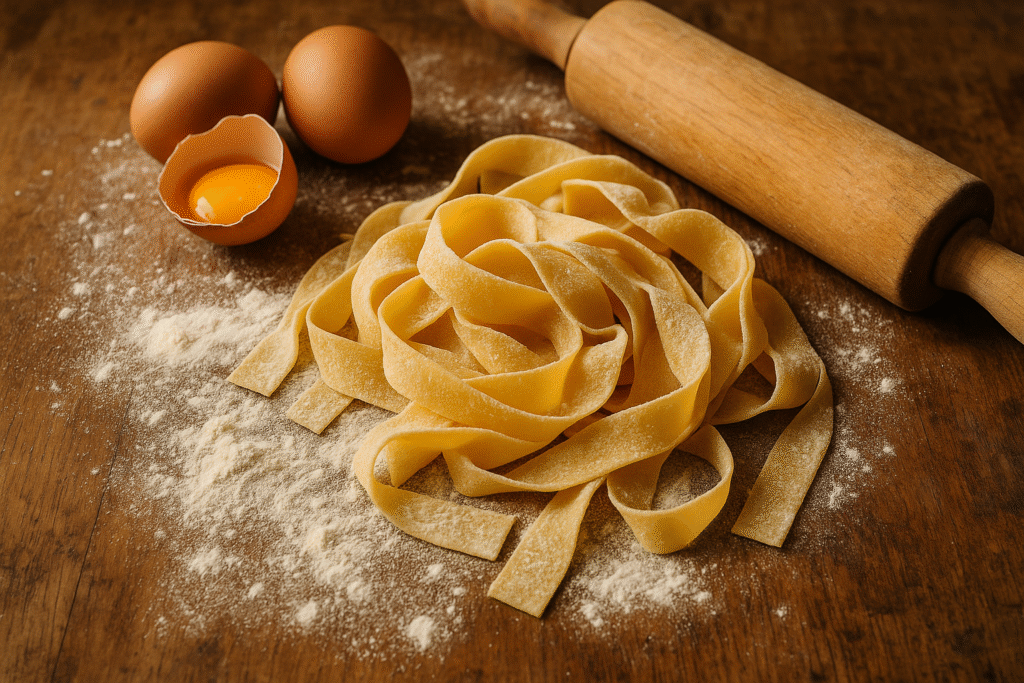
The Origins and Unique Texture of Pappardelle Pasta
Pappardelle pasta is a traditional Italian wide ribbon noodle, typically made from egg-based dough and cut into thick strips usually about ¾ to 1 inch wide. It hails from Tuscany, a region known for its bold meat sauces and rustic charm. Its name comes from the verb pappare, which means “to gobble up” and trust me, that’s exactly what you’ll want to do when it’s on your plate.
What makes pappardelle stand out is its flat, sturdy surface that clings beautifully to hearty sauces like Bolognese, ragu, and mushroom cream. Its broad texture soaks up every bit of flavor, offering a rich, luxurious bite with each forkful.
If you’re a fan of comfort food, pappardelle’s got your back. Think of it as the cozy sweater of the pasta world.
Don’t miss our creamy cottage cheese bagels recipe another surprising comfort food you can whip up at home.
Pappardelle vs. Other Pasta: Why It’s Special
While tagliatelle and fettuccine might be more common on dinner tables, pappardelle’s width gives it a unique personality. It’s particularly well-suited for:
- Slow-cooked beef or pork ragus
- Wild mushroom sauces
- Creamy, cheesy blends
- Even vegetarian options with kale, squash, or walnuts
It’s a versatile noodle that doesn’t play second fiddle to anything you pair it with.
How to Cook and Pair Pappardelle Pasta Like A Pro
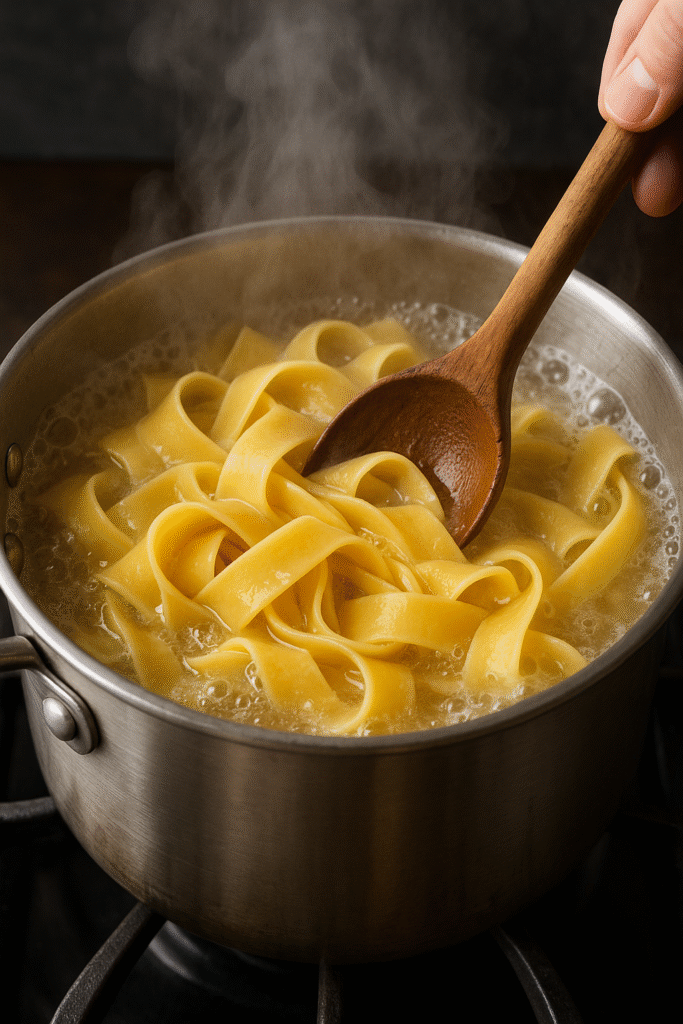
Cooking Pappardelle to Perfection
When it comes to pappardelle pasta, nailing the texture is everything. You want it tender but firm enough to hold up to bold sauces. Here’s how I do it every time:
- Use a big pot with lots of salted water roughly 4 to 5 quarts per pound of pasta. Pappardelle need room to swirl.
- Don’t overcook. Fresh pappardelle cooks in 2–4 minutes, while dried takes 7–9. Start testing early to avoid mush.
- Stir gently right after adding it to the pot. These wide noodles love to stick if left alone.
- Reserve some pasta water before draining. The starch helps bind your sauce to the pasta for that glossy, restaurant-style finish.
Cooking pappardelle right means every bite is layered in flavor and texture.
If you’re experimenting with sauces, try this hot honey beef bowl recipe its bold flavors are perfect with a base like pappardelle instead of rice.
Pairing the Right Sauce with Pappardelle Pasta
Pappardelle pasta pairs best with rich, thick sauces that cling to its wide surface. Here’s a quick guide:
| Sauce Type | Why It Works | Ingredients to Try |
|---|---|---|
| Ragu | Deep, meaty flavors match the pasta’s heft | Beef, pork, tomatoes, red wine |
| Creamy Sauces | Luxurious sauces coat each ribbon evenly | Mushrooms, garlic, Parmesan, heavy cream |
| Herby Butter Sauces | Simpler but fragrant and satisfying | Sage, brown butter, lemon zest |
| Veggie Sauces | Add contrast with brightness and texture | Kale, butternut squash, cherry tomatoes |
One of my all-time favorite combos is a wild mushroom and truffle cream sauce. The earthy depth mixed with the eggy chew of pappardelle is just…wow.
For a lighter twist, check out this detox island green smoothie to pair as a refreshing side drink with a rich pasta dinner.
Homemade vs. Store-Bought Pappardelle Pasta: Which One Wins?
The Charm of Homemade Pappardelle
There’s something deeply satisfying about making pappardelle pasta from scratch. It’s tactile, it’s slow, and it connects you to generations of Italian tradition. If you’ve never tried it before, don’t worry. All you need are four ingredients: flour, eggs, salt, and love.
Here’s why homemade pappardelle is worth the effort:
- Texture control: You get to choose how thick or thin you want your ribbons.
- Fresh flavor: Homemade pasta has a richer taste that absorbs sauces beautifully.
- Creative freedom: Add herbs, spinach, or beet puree to the dough for color and flavor.
Rolling out the dough and slicing wide ribbons by hand reminds me of quiet Sunday afternoons when everything slowed down. The smell of flour dust in the air, the rhythmic clack of the pasta cutter pure joy.
Want a sweet project for the weekend? Try making this banana pudding ice cream sandwich after your homemade pasta night. It’s a perfect finisher.
When Store-Bought Pappardelle Makes Sense
Let’s be real. Life gets busy. And there’s no shame in reaching for a quality box of pappardelle pasta when time’s tight. The key is choosing a brand with high egg content and bronze-cut texture. These characteristics help the noodles mimic homemade quality.
Here’s when store-bought shines:
- Weeknight dinners: You can have dinner on the table in 20 minutes.
- Consistent results: You don’t have to worry about uneven thickness or texture.
- Great for testing sauces: Use boxed pasta while experimenting with new flavors.
Whether you make it or buy it, what matters most is what you do with it.
If you’re looking to expand your comfort food collection, discover this rock bottom pie recipe. It’s simple, indulgent, and perfect after a savory pasta dish.
Irresistible Recipes to Make with Pappardelle Pasta
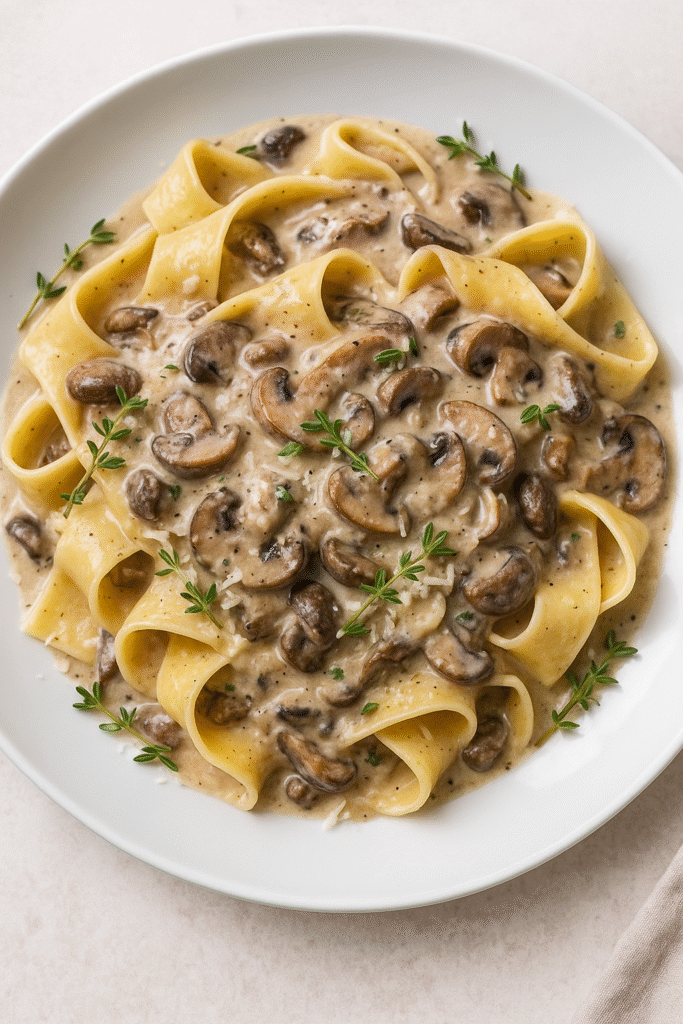
Classic Italian Pappardelle Recipes That Never Fail
One of the reasons I love pappardelle pasta is because it turns simple ingredients into unforgettable meals. Its wide surface catches just enough sauce, and its rustic feel makes everything taste a bit more comforting. If you’re wondering what to do with pappardelle pasta, these classic dishes are a great starting point.
1. Pappardelle alla Bolognese
This dish is the soul of Tuscan comfort food. A slow-simmered meat sauce, rich with tomatoes, garlic, and red wine, wraps around each ribbon like a hug. Pair it with a sprinkle of Parmesan and maybe a glass of Chianti.
2. Pappardelle with Wild Mushroom Cream Sauce
This one is earthy, creamy, and ready in under 30 minutes. A mix of shiitake, cremini, and porcini mushrooms sautéed in butter and finished with heavy cream brings out deep umami notes. Add cracked pepper and thyme for even more depth.
Craving a sweet follow-up? Check out this Dubai chocolate strawberries recipe that’s perfect for dessert after a rich pasta dinner.
Creative Ways to Use Pappardelle at Home
Pappardelle isn’t just for Italian nights. Get creative with these unique spins:
- Pappardelle Stir Fry: Toss cooked pasta with sesame oil, soy sauce, ginger, garlic, and veggies for a fun fusion.
- Lemon-Garlic Shrimp Pappardelle: Bright and zesty, with a protein-packed punch.
- Pappardelle with Butternut Squash and Sage: A vegetarian masterpiece full of fall flavor.
Don’t be afraid to try bold pairings. The wide, hearty texture of pappardelle holds up well to a variety of ingredients, even spicy ones.
Looking for something light to go alongside these dishes? Try this vegan banana pudding. It’s dairy-free and a great palate cleanser.
Nutrition Facts, Serving Tips, and How to Store Pappardelle Pasta
Is Pappardelle Pasta Healthy? Here’s What You Need to Know
If you’re wondering whether pappardelle pasta can fit into a balanced diet, the answer is yes with a few smart choices. Traditional pappardelle are made with semolina or all-purpose flour and eggs, which gives it a higher protein content than plain pasta. One serving (about 2 ounces of dry pasta) typically offers:
| Nutrient | Amount per Serving |
|---|---|
| Calories | 210–240 kcal |
| Protein | 7–9 grams |
| Carbohydrates | 40–45 grams |
| Fat | 2–3 grams |
To keep your meal on the healthier side:
- Use olive oil instead of butter-based sauces
- Add leafy greens, lean meats, or roasted vegetables
- Stick to proper portion sizes (especially with rich sauces)
Need a guilt-free treat after your pasta? Take a look at this air fryer date s’mores recipe for a naturally sweet, better-for-you dessert.
How to Serve and Store Pappardelle Like a Pro
Serving tips:
- Always toss the pasta in the sauce right before serving. This coats every ribbon evenly and keeps the dish warm.
- Garnish matters: Add shaved Parmesan, fresh basil, or crushed red pepper to elevate the experience.
- Warm the plates: Hot pasta on a cold plate? No thanks. Heat your dishes for 1–2 minutes in the oven.
Storage tips:
- Fresh pappardelle: Wrap tightly in plastic and refrigerate for up to 2 days, or freeze it on a tray before transferring to a bag for long-term use.
- Cooked pasta: Store in an airtight container with a little olive oil mixed in. It’ll stay good in the fridge for up to 3 days.
- Leftover sauce: Always keep sauce separate when storing. This preserves texture and makes reheating easier.
Looking for another pasta-forward option with a nutritious twist? Don’t miss this protein baked oats recipe that’ll power up your mornings after a big Italian dinner.
The Origins and Surprising Facts About Pappardelle Pasta
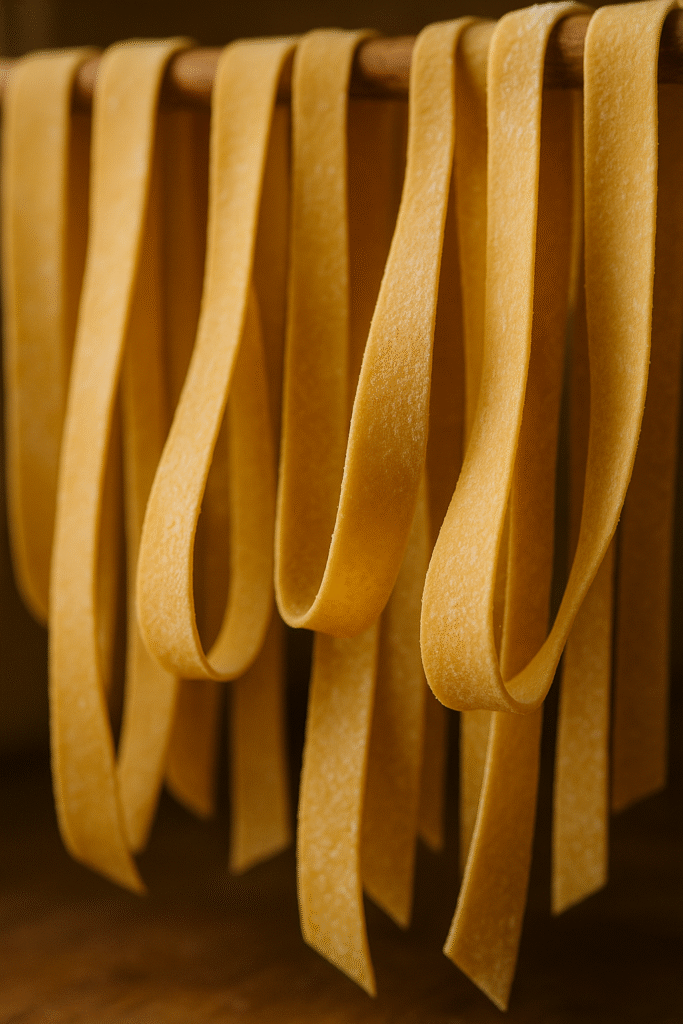
Where Pappardelle Pasta Comes From and Why It’s So Special
The roots of pappardelle pasta go deep into the heart of Tuscany, a region known for its rustic countryside and slow-cooked cuisine. The name “pappardelle” comes from the Italian verb pappare, meaning “to gobble up,” which feels incredibly accurate once you try it.
Historically, pappardelle was made by hand in Italian farmhouses, especially during colder months. Families would roll out sheets of egg-enriched dough and cut them into long, thick ribbons. These wide noodles were perfect for the bold meat sauces that were typical of Tuscan kitchens.
What makes pappardelle different from other pasta shapes is its width. Unlike spaghetti or fettuccine, which are more delicate, pappardelle holds up to heavy ragùs, braised meats, and mushroom sauces. Its texture allows it to soak up flavor beautifully, making it ideal for heartier, cold-weather meals.
Craving a creative pairing? Try this Fumang Propitious Mango Ice Cream for dessert. It’s rich, tropical, and a perfect contrast after a savory Tuscan dish.
Fun Facts You Probably Didn’t Know About Pappardelle
- It’s often served during festivals in Italy, especially during hunting season when wild boar ragù is on the menu.
- The traditional version uses duck or hare ragù, which was considered a delicacy in rural regions.
- Fresh pappardelle is best made with 00 flour and semolina, giving it both softness and a bit of bite.
- Pappardelle is part of the “egg pasta” family, meaning it’s richer and more luxurious than many dried pastas.
- Chefs around the world use it in fusion recipes, including Asian-inspired stir-fries and plant-based dishes.
For a lighter recipe idea, check out this lactose-free cottage cheese guide. It’s a great side ingredient if you’re exploring dairy-light pappardelle variations.
Pappardelle isn’t just a pasta. It’s a celebration of heritage, of hearty meals, of family dinners that leave you full in all the best ways. The next time someone asks, “what kind of pasta is pappardelle?” you’ll have a whole story to share.
Pronunciation, Pasta Twins, and Common Questions About Pappardelle
How Do You Pronounce Pappardelle Pasta?
One of the first questions people ask when they see pappardelle pasta on a menu is how to say it. It’s pronounced pah-par-DEL-leh, with the emphasis on the third syllable. The final “e” isn’t silent like in English. It’s a smooth, rhythmic word that feels good to say, especially if you’re rolling it off your tongue before a delicious dinner.
If you’re practicing your pronunciation, say it out loud while stirring your sauce. It’s part of the fun. Italian food isn’t just about taste it’s also about the experience.
And speaking of fun food experiences, you’ll love this Dubai chocolate bar recipe that adds flair to dessert just like pappardelle does to dinner.
What Pasta is Similar to Pappardelle?
While pappardelle pasta stands out for its wide, ribbon-like shape, there are a few other pastas that come close in form and function.
| Pasta Type | Width | Best For |
|---|---|---|
| Fettuccine | Narrower | Lighter cream sauces |
| Tagliatelle | Slightly thinner | Meat sauces, lighter ragùs |
| Lasagna Sheets | Similar width | Often cut down into pappardelle |
If you’re out of pappardelle, tagliatelle is a good substitute, especially for thick meat sauces. But honestly, nothing quite replaces the bite and presence that real pappardelle brings to the plate.
Want a healthy twist on a pasta-like meal? Explore this recipes with apple cider vinegar for weight loss to balance out those carb-rich dinners with something detoxifying.
Why Pappardelle Is Worth Trying If You Haven’t Yet
Pappardelle has this beautiful way of turning a simple dish into something memorable. It’s thick without being heavy, indulgent without being overwhelming. Whether you’re working with a store-bought sauce or simmering a ragu all afternoon, this pasta elevates the whole meal.
And yes, once you get the hang of saying it, you’ll want to tell everyone what you’re making for dinner.
Pro Tips and Chef Tricks to Elevate Your Pappardelle Pasta Dishes
Cook Like a Chef with These Expert Tips
If you want to turn your pappardelle pasta from good to unforgettable, it’s all about the little things. Professional chefs have a few tricks up their sleeves that home cooks can easily adopt. These smart techniques add depth, balance, and restaurant-level flavor to your dishes.
1. Always salt your water like the sea
This isn’t just a cliché. Heavily salted water enhances the taste of the pasta itself, not just the sauce. Since pappardelle pasta is thicker than other noodles, seasoning the pasta water ensures flavor in every bite.
2. Finish cooking the pasta in the sauce
Drain your pasta a minute early and toss it into your simmering sauce. Let it finish cooking together for that silky, cohesive texture that binds everything into one delicious experience.
3. Add starchy pasta water
Scoop out a cup before draining. That starchy water creates a velvety sauce and helps it cling better to each ribbon of pappardelle.
4. Use a wide pan for tossing
A large, shallow skillet gives your pasta enough room to mix thoroughly with your sauce. You want every inch of those wide noodles coated in flavor.
Looking for a bold flavor pairing? Try this Brazilian Mounjaro recipe for something spicy and protein-packed. It makes a great sidekick to creamy or tomato-based pappardelle.
Bonus Hacks for More Flavor and Presentation
- Add acid: A splash of lemon juice or balsamic vinegar can brighten up a rich sauce.
- Top with texture: Crunchy toasted breadcrumbs or crushed walnuts provide a nice contrast to the soft noodles.
- Layer in herbs: Instead of just using herbs at the end, stir some into the sauce while it simmers. Fresh basil, rosemary, or thyme can make your pappardelle pasta taste truly elevated.
Presentation matters too. Use tongs to twirl your pasta into a mound on each plate and top with a generous shaving of Parmesan. It’s a small touch that creates a restaurant-worthy feel at home.
Want to stay healthy while eating pasta? Don’t miss this guide on pink salt tricks for weight loss that pairs well with any Mediterranean-style meal plan.
Common Mistakes to Avoid When Making or Serving Pappardelle Pasta
Don’t Overcook Your Pappardelle Pasta
The biggest sin when it comes to pappardelle pasta is overcooking it. Because of its wide and thick structure, it’s easy to let it go too long in the pot. The result is mushy noodles that lose their ability to hold sauce. The solution? Always test it two minutes earlier than the package suggests. Fresh pappardelle usually needs just 2 to 4 minutes, while dried versions go for 7 to 9.
Tip: Pasta continues cooking even after it’s drained. Toss it in the sauce immediately to prevent it from becoming overdone.
If you’re into precise, recipe-based cooking, take a look at this cottage cheese bread. It shows how important timing and technique are in any kitchen creation.
Using the Wrong Sauce or Serving Cold
Another mistake is pairing pappardelle pasta with sauces that are too thin or light. This pasta is made to hold weighty, velvety sauces. Think Bolognese, mushroom cream, or even a lamb ragu. Anything too watery will slide off and leave you with bland bites.
Also, never serve pappardelle cold unless you’re preparing a unique pasta salad. This kind of noodle was meant to be warm and coated in sauce. Cold temperatures can make the wide ribbons stiff and chewy.
A great way to round out your pasta dinner is with a light but creamy treat. Try this ninja creami vanilla ice cream for a smooth, cool finish.
Other Mistakes to Watch Out For
- Skipping the salt in pasta water: It’s your only chance to season the noodle itself.
- Tossing pasta with oil before sauce: This creates a barrier and keeps sauce from sticking.
- Using a small pot or pan: You need space for pappardelle to cook and mix properly.
Avoiding these mistakes is the easiest way to make sure every bite of your pappardelle pasta is flavorful, satisfying, and cooked just right.
Frequently Asked Questions About Pappardelle Pasta
What kind of pasta is pappardelle?
Pappardelle pasta is a wide, flat ribbon-shaped noodle that originates from Tuscany, Italy. It’s typically made with an egg-based dough, which gives it a rich flavor and soft, chewy texture. This pasta is best known for pairing with hearty sauces like Bolognese, lamb ragu, or wild mushroom cream. Because of its width, pappardelle hold sauce beautifully, making each bite incredibly satisfying.
How do you pronounce pappardelle pasta?
It’s pronounced pah-par-DEL-leh. The stress falls on the third syllable, and the final is fully pronounced, just like in Italian. Say it with confidence next time you’re serving it it’s part of the charm and authenticity of cooking with regional pasta shapes like pappardelle pasta.
What pasta is similar to pappardelle?
If you can’t find pappardelle pasta, tagliatelle and fettuccine are your next best options. They’re slightly narrower but still wide enough to carry thick sauces. You can also cut lasagna sheets into ribbons to mimic pappardelle in a pinch. Still, nothing matches the bold, rustic feel of true pappardelle.
What to do with pappardelle pasta?
There’s a world of options when cooking with pappardelle pasta. Try it with a slow-cooked meat ragu, a creamy mushroom and thyme sauce, or a vibrant lemon and shrimp mix. You can also experiment with vegetarian toppings like roasted squash and walnuts or sautéed greens with garlic and olive oil. This pasta’s wide shape opens up endless possibilities for flavor.
Can I use pappardelle pasta for vegetarian dishes?
Absolutely. Pappardelle pasta is incredibly versatile and works well in vegetarian recipes. Toss it with roasted vegetables, caramelized onions, sautéed kale, or a creamy cauliflower sauce. Its ability to hold flavor-rich, chunky toppings makes it a perfect base for plant-based meals.
Is pappardelle pasta available gluten-free?
Yes, you can find gluten-free pappardelle pasta made with alternative flours like brown rice, quinoa, or lentils. There are even artisanal brands that produce egg-free and vegan options. Just be sure to follow the cooking times closely, as gluten-free pasta tends to soften quickly.
Bring Pappardelle Pasta into Your Kitchen Tonight
From its rich Tuscan roots to its undeniable ability to hold bold, flavorful sauces, pappardelle pasta is more than just a type of noodle it’s a culinary experience. Whether you’re making it fresh at home or grabbing a high-quality dried version, this pasta transforms simple ingredients into meals worth remembering.
Don’t be afraid to get creative. Use it for meat-based dishes, vegetarian favorites, or even fusion recipes. You now know how to cook it properly, avoid the most common mistakes, and impress your guests with pronunciation, presentation, and pairing.
To keep the inspiration going, check out this mango propitious ice cream recipe for a fresh and fruity dessert idea after your pasta night. Or browse this flavorful low-carb chicken Alfredo bake for another savory kitchen win.
Love recipes like this? Join our growing foodie community and get fresh updates by following us on Facebook and Pinterest.
With the tips, tricks, and ideas in this guide, your next pappardelle pasta dish could be your best one yet.
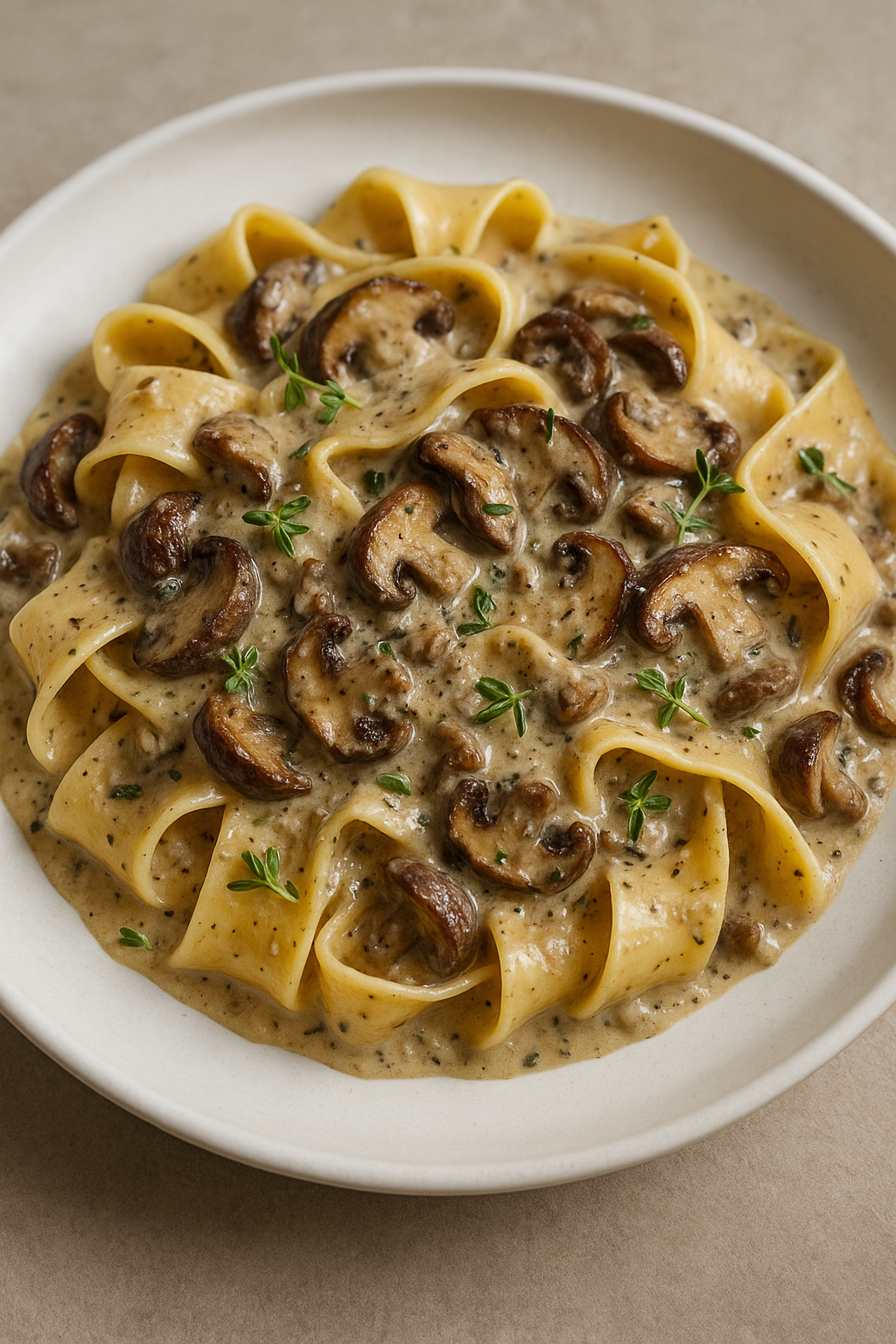
How to Master the Art of Pappardelle Pasta: A Deliciously Complete Guide
Ingredients
Method
- 1. Bring a large pot of salted water to a boil and cook the pappardelle until al dente. Reserve 1/2 cup of pasta water and drain.
- 2. In a large skillet, heat olive oil over medium heat and sauté garlic until fragrant.
- 3. Add mushrooms and cook until soft and browned.
- 4. Pour in the heavy cream and stir in Parmesan cheese. Let simmer for 2–3 minutes.
- 5. Add the cooked pasta to the sauce and toss well. Add reserved pasta water to loosen if needed.
- 6. Season with salt and pepper. Top with fresh thyme and more cheese if desired.
- 7. Serve warm and enjoy!


2 thoughts on “How to Master the Art of Pappardelle Pasta: A Deliciously Complete Guide”